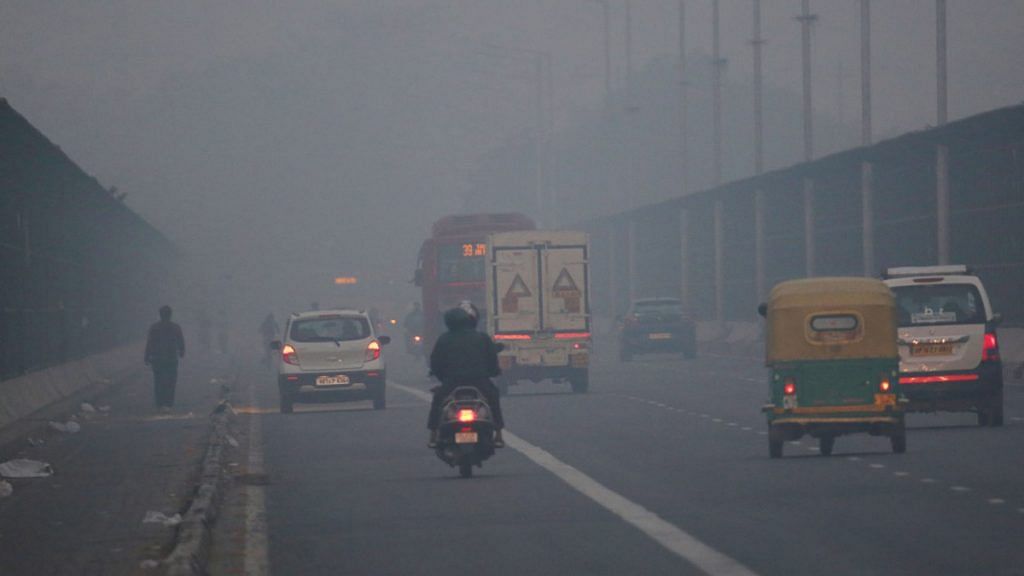Bengaluru: A new study shows that exposure to air pollution for a year increases the risk of brain cancer by 10 per cent. This is the first time concrete research has linked air pollution to brain cancer.
The Canadian study, published in the journal Epidemiology this week, traces the connection of PM0.1, the nano-polluting particles found in tailpipe emissions of diesel vehicles, to brain cancer. While cancers of the brain are rare, the research shows that they are on the rise in places with higher pollution levels.
Ultrafine particles (UFPs)
PM0.1 are 0.1 micrometers (µm) in diameter and are much smaller than PM2.5 and PM10. They are considered ultra-fine particles (UFP), produced by burning fossil fuels, and are considered a major concern for respiratory problems.
UFPs are classified as nanoparticles and are of two types — carbon-based and metallic.
These particles are so small that they can penetrate the protective membrane called the blood-brain barrier and enter the brain more easily than PM2.5. They first accumulate on the lungs, penetrate the tissues and then enter the bloodstream.
The researchers from McGill University in Canada conducted the study within city limits of Montreal and Toronto. They studied the combined population of 1.9 million adults and measured their UFP exposure from census data from 1991 to 2016.
The study discovered that 1,400 brain tumour cases were reported during this period. As residents moved through cities or moved from less polluted cities to more polluted ones, the researchers found that an increase in UFP exposure by 10,000 in a cubic centimetre volume increased the risk of brain tumour by 10 per cent.
Also read: Pollution, climate change, malnutrition will affect our kids for life, Lancet report says
Several other studies
The study comes in the wake of several other studies that reveal the effects of air pollution on the human brain.
A 2016 study showed that in the UK, magnetite particles from air pollution were discovered in the brains of 37 people, significantly increasing their risk of Alzheimer’s disease. Another study, from 2018, showed that PM10 and particles smaller than that cause a decline in cognitive functions, especially in adult men. Air pollution may also be responsible for nearly 30 per cent of all strokes, according to the Global Burden of Disease Study from 2013.
“Over the last 70 years, there has been a cause for concern because the levels of pollutant gases in ambient air has gone up phenomenally,” said Navakanta Bhat, professor and chairperson at Indian Institute of Science, Bangalore’s Centre for Nano Science and Engineering, to ThePrint.
“For example, carbon dioxide is one of the most important greenhouse gasses, and its concentration has gone up by 30%, which is a grave cause of concern for us,” he added.
Also read: What is hydrogen fuel? Supreme Court’s solution to Delhi’s air pollution crisis
Air pollution affects the entire human body
It isn’t just the brain, various researches have already established that air pollution affects
the entire body. It has been linked to heart diseases and congenital heart defects, diabetes, all kinds of breathing disabilities and diseases, other kinds of cancer and blood pressure increase. According to the World Health Organisation, an estimated 4.2 million premature deaths are directly linked to ambient air pollution.
A detailed review of air pollution studies earlier this year also indicated that air pollution damages every single cell in the human body. A link between UFPs and vascular diseases was established seven years ago.
There are four main culprits in tailpipe emissions that are a major concern: Carbon dioxide, carbon monoxide, nitrogen dioxide, and sulphur dioxide. These are the gases released by incomplete combustion of fossil fuels — the process through which energy is generated in vehicles and industries.
“These gases really concern us,” said Bhat, who is also the 2018 Life Science winner of the Infosys Prize. “If you look at the composition of ambient air as we studied in school, 78 per cent is Nitrogen which is inert and harmless, 21 per cent is Oxygen which is a lifeline for all living beings, and the remaining 1 per cent is composed of a large number of gases called trace gases.”
The nanoparticle-emitting gases fall in the last category.
Research on PM0.1 is also gaining ground as its effects on the human body and the small particles’ ability to penetrate human tissues comes to light. These are now found in large quantities in not just heavily polluted cities but also those cities that are considered
relatively cleaner in comparison.
However, regulations still don’t exist for UFPs but this scenario is likely to change in the near future.
Also read: Paddy seeds being developed in Punjab could fix North India’s pollution problem next year
